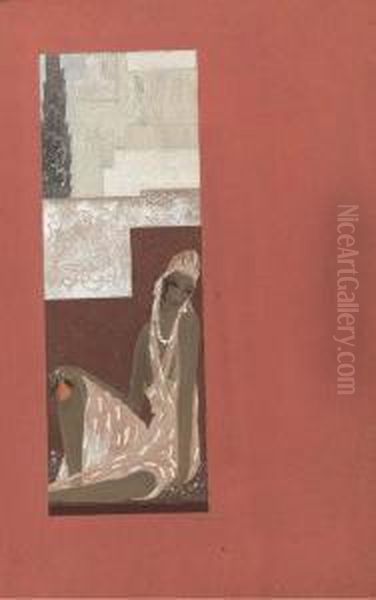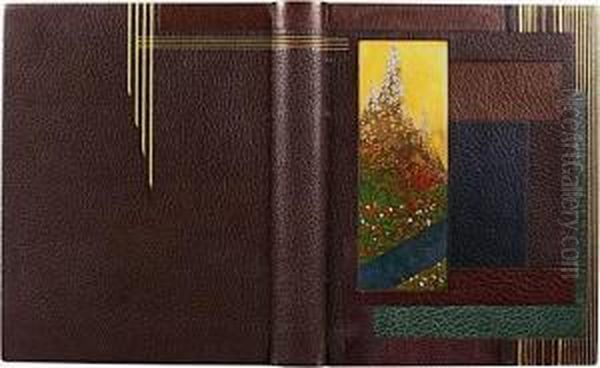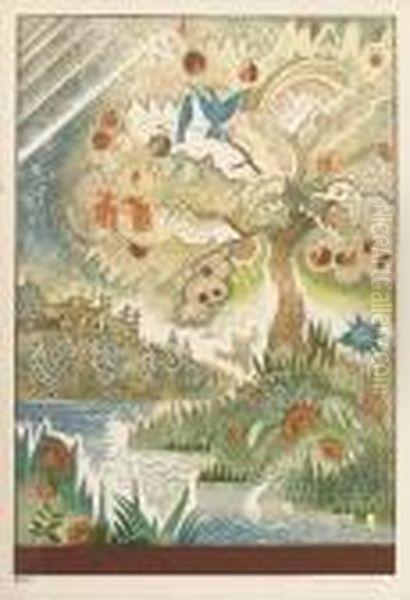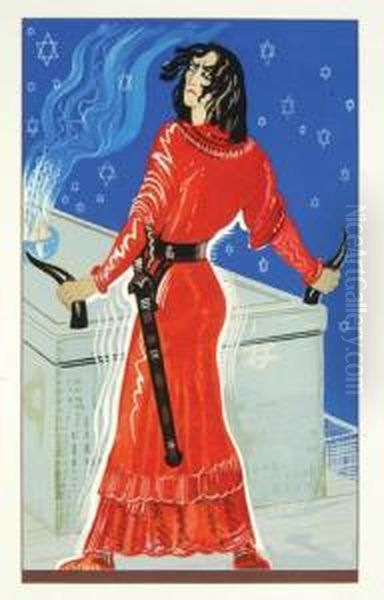François-Louis Schmied stands as a monumental figure in the annals of 20th-century art, a polymath whose talents spanned painting, wood engraving, printing, editing, illustration, and bookbinding. Born in Geneva, Switzerland, on November 8, 1873, Schmied's journey would lead him to become a naturalized French citizen and one of the most distinguished proponents of the Art Deco style, particularly within the rarefied world of the livre d'artiste (artist's book). His meticulous craftsmanship, innovative techniques, and distinctive aesthetic sensibility left an indelible mark on the landscape of fine book production, creating objects of exquisite beauty that continue to captivate collectors and scholars alike.
Early Life and Artistic Formation
Schmied's artistic inclinations were nurtured from a young age. His formal training began in his native Geneva, a city with a rich tradition in precision crafts, at the École des Arts Industriels (School of Industrial Arts), specifically within the Guillaume Le Bé section, which focused on graphic arts. It was here that he encountered Barthélemy Menn (1815-1893), a significant Swiss painter who had himself studied under Jean-Auguste-Dominique Ingres and was a friend to titans of French art like Jean-Baptiste-Camille Corot and Eugène Delacroix. Menn's influence, with his emphasis on rigorous drawing and a deep appreciation for classical composition, undoubtedly provided a strong foundation for Schmied's developing artistic vision.
Seeking to further hone his skills, particularly in the demanding medium of wood engraving, Schmied studied with the master engraver Alfred Martin. This period was crucial for developing the technical virtuosity that would become a hallmark of his work. Wood engraving, a relief printing technique where the image is incised into the end-grain of a block of wood, requires immense precision and control. Schmied would not only master this traditional craft but also push its boundaries, particularly in the realm of color printing.

By 1895, at the age of 22, Schmied made the pivotal decision to move to Paris, the undisputed epicenter of the art world at the turn of the century. He initially found work as a commercial engraver, a practical application of his skills that provided him with a livelihood while he immersed himself in the vibrant artistic milieu of the French capital. This period of practical application further refined his technical abilities and gave him an intimate understanding of the printing process.
The Parisian Art World and the Rise of Art Deco
Paris in the early 20th century was a crucible of artistic innovation. Movements like Fauvism, Cubism, and Futurism were challenging established conventions, and a new decorative style, which would later be known as Art Deco, was beginning to coalesce. This style, emerging fully in the 1920s and 1930s, was characterized by rich ornamentation, geometric forms, stylized natural motifs, luxurious materials, and a celebration of modernity and craftsmanship. It drew inspiration from a diverse array of sources, including the bold geometry of Cubism, the vibrant colors of Fauvism, the exoticism of African, Egyptian, and East Asian art, and the sleek dynamism of the machine age.
Schmied's meticulous approach and his flair for decorative elegance found a natural resonance with the burgeoning Art Deco aesthetic. His work began to attract attention, and a significant turning point occurred in 1910 (some sources state 1911) when he was commissioned by the exclusive bibliophile society, Les Sociétés des Livres Contemporains. This commission marked his entry into the prestigious world of limited-edition, high-quality illustrated books, a field in which he would become a dominant force.
The era was ripe for such luxurious productions. A wealthy clientele of collectors and bibliophiles appreciated books that were not merely carriers of text but complete works of art, where every element – typography, illustration, paper, printing, and binding – was harmoniously integrated. Artists like Georges Barbier, André Édouard Marty, and George Lepape were creating stunning fashion plates and illustrations that epitomized the elegance of the era, often utilizing the pochoir (stencil) technique for vibrant color. While Schmied's primary medium for illustration was the woodcut, his work shared their commitment to decorative richness and sophisticated design.
Mastery of Wood Engraving and Color Printing
François-Louis Schmied's genius lay not only in his artistic vision but also in his profound technical mastery, particularly in wood engraving and the complex processes of color printing. He elevated wood engraving to an art form of incredible subtlety and richness, often rivaling the tonal complexities of painting.

Traditional color woodcut printing, as famously practiced in Japanese ukiyo-e, involved using multiple blocks, one for each color. Schmied adopted and refined this multi-block technique to achieve astonishingly nuanced and vibrant results. Each color in his illustrations required a separately carved woodblock, precisely registered to align perfectly with the impressions from other blocks. This process demanded meticulous planning, flawless carving, and expert printing. Some of his more elaborate illustrations could involve dozens of blocks, each inked with a carefully chosen hue, often including metallic inks like gold and silver to enhance the luxurious quality of the final image.
His studio became a hub of such intricate work. He oversaw every aspect of production, from the initial design and carving of the blocks to the mixing of inks and the final printing. The quality of his printing was exceptional, characterized by even ink application, crisp impressions, and perfect registration. He often experimented with different types of paper, selecting surfaces that would best complement the textures of the woodcuts and the richness of the inks. This holistic approach to bookmaking was central to his philosophy.
The results were images of extraordinary depth and luminosity. His woodcuts could achieve delicate gradations of tone, sharp geometric precision, and sumptuous decorative patterns. He understood how to exploit the inherent qualities of the woodblock – the way the grain could add texture, the crispness of the incised line – to create images that were both graphically powerful and exquisitely detailed. This technical prowess set him apart and allowed him to realize his ambitious artistic visions for the books he produced.
The Art Deco Aesthetic in Schmied's Work
Schmied's mature style is inextricably linked with Art Deco. His illustrations and book designs are quintessential examples of this movement's elegance, sophistication, and embrace of decorative richness. Several key characteristics of Art Deco are prominent in his work:
Geometric Forms and Stylization: Schmied frequently employed bold geometric shapes, streamlined forms, and stylized representations of natural elements. Figures are often rendered with a statuesque, almost monumental quality, and landscapes are transformed into highly ordered, decorative compositions. This can be seen in the angularity of his figures and the structured patterns that often form the backdrops of his scenes.
Rich Color Palettes and Luxurious Materials: His color choices were often opulent and dramatic, featuring deep jewel tones, vibrant contrasts, and the lavish use of gold, silver, and sometimes platinum inks. This contributed to the sense of luxury and exclusivity that characterized Art Deco design. The very materials of his books – high-quality papers, fine bindings – further enhanced this impression.

Exoticism and Orientalism: Like many Art Deco artists, Schmied drew inspiration from non-Western art forms. Influences from Egyptian, Persian, Japanese, and African art are discernible in his motifs, color schemes, and compositional strategies. This exoticism added an element of fantasy and allure to his work, appealing to the sophisticated tastes of his clientele. For instance, his work on Le Paradis Musulman by Myriam Harry clearly demonstrates this engagement with Orientalist themes.
Integration of Text and Image: Schmied was not merely an illustrator; he was a book designer in the truest sense. He paid meticulous attention to typography, page layout, and the overall pacing and structure of the book. Illustrations were not simply inserted into the text but were conceived as integral parts of a unified design. He often designed his own typefaces or selected existing ones that harmonized with his visual style. The interplay between text blocks, illustrations, decorative borders, and even blank space was carefully considered to create a cohesive and aesthetically pleasing whole.
Craftsmanship and Modernity: Art Deco, despite its embrace of modern aesthetics, also placed a high value on traditional craftsmanship. Schmied epitomized this duality. His use of the age-old technique of wood engraving, executed with unparalleled skill, was combined with a thoroughly modern design sensibility. His books were handcrafted objects of art, yet they spoke to the dynamism and sophistication of the modern era.
His contemporaries in the broader field of Art Deco design, such as the furniture maker Jacques-Émile Ruhlmann, the metalworker Edgar Brandt, the glass artist René Lalique, and the fashion illustrator Erté (Romain de Tirtoff), all shared this commitment to exquisite craftsmanship, luxurious materials, and a stylized, elegant modernism. Schmied's books can be seen as the bibliographic counterparts to their creations in other media.
Key Collaborations and Influences
Throughout his career, François-Louis Schmied engaged in several significant collaborations that enriched his work and expanded his artistic network. One of his most notable collaborators was the French animalier artist and sculptor Paul Jouve (1878-1973). Jouve, renowned for his powerful depictions of wild animals, particularly big cats, shared Schmied's meticulous approach and dedication to craftsmanship. Their most celebrated collaboration was on Rudyard Kipling's Le Livre de la Jungle (The Jungle Book).

Another important figure in Schmied's circle was Jean Dunand (1877-1942), a Swiss-French artist who was a master of lacquerware, metalwork, and sculpture. Dunand also contributed to some of Schmied's book projects, including providing designs or decorative elements. Dunand, along with Jean Goulden and Paul Jouve, was part of a close-knit group of artists who often exhibited together and shared a similar Art Deco sensibility. Gustave Miklos (1888-1967), a sculptor and designer of Hungarian origin who became a prominent figure in French Art Deco, also collaborated with Schmied, particularly on decorative elements and bindings, bringing his own distinct geometric and abstract style to these projects.
The influence of his early mentor, Barthélemy Menn, with his connections to Corot and Delacroix, provided Schmied with a lineage rooted in strong academic traditions, even as he forged a modern path. The broader Parisian art scene, with figures like Sonia Delaunay, whose Orphist paintings explored color and form in ways that resonated with decorative applications, and Raoul Dufy, who successfully transitioned from Fauvism to decorative arts and textile design, created an environment where the boundaries between fine and applied arts were increasingly fluid. Schmied's work thrived in this interdisciplinary atmosphere.
In 1930, a young American lawyer and aspiring printer named Ward Ritchie traveled to Paris specifically to learn from Schmied. Ritchie spent time in Schmied's studio, assisting with printing and absorbing the master's techniques and artistic philosophy. This encounter had a lasting impact on Ritchie, who would go on to become an influential fine press printer in California.
Landmark Publications: A Closer Look
François-Louis Schmied's reputation rests firmly on a series of magnificent illustrated books that are now considered masterpieces of Art Deco book production.
Le Livre de la Jungle (The Jungle Book) by Rudyard Kipling: This project, undertaken with Paul Jouve, is perhaps Schmied's most famous work. The initial work began before World War I, which interrupted its progress as Schmied served in the French Foreign Legion and was seriously wounded. The book was finally published in 1919. Schmied was responsible for the typography, layout, and the intricate color wood engravings that brought Kipling's tales to life with a unique blend of exoticism and Art Deco stylization. Jouve provided powerful animal drawings that Schmied translated into the woodcut medium. The result was a visually stunning edition that garnered widespread acclaim and solidified Schmied's position in the French book world.
Daphné by Alfred de Vigny: Published in 1924, this edition of Vigny's classical tale is another high point of Schmied's career. The illustrations are characterized by their bold compositions, rich colors (including extensive use of gold), and a statuesque, almost frieze-like quality in the depiction of figures. The typography is adventurous and perfectly integrated with the images. Daphné is often cited as a quintessential example of Art Deco book design, showcasing Schmied's ability to create a total work of art where every detail contributes to the overall effect. Critics lauded its innovative design and exquisite execution.
Le Cantique des Cantiques (The Song of Songs): Schmied produced a breathtaking edition of this biblical text, likely published in 1925. The illustrations are imbued with a sensuous, lyrical quality, employing a rich palette and intricate decorative patterns. Some interpretations suggest a Pointillist influence in the way colors are juxtaposed to create vibrant effects. The work captures the poetic intensity and romanticism of the original text through a distinctly Art Deco lens.
Salammbô by Gustave Flaubert: For Flaubert's historical novel set in ancient Carthage, Schmied created illustrations that evoked the grandeur and exoticism of the setting. His style here drew on Egyptian and Near Eastern art, with hieratic figures and stylized architectural elements, all rendered with his characteristic precision and decorative flair.
Histoire de la Princesse Boudour (The Tale of Princess Budur): This was a project based on a tale from The Arabian Nights, translated by Dr. J.C. Mardrus. Schmied designed and produced this volume, which, like his other works inspired by Oriental themes, featured lavish illustrations, rich colors, and intricate patterns, perfectly capturing the magical and exotic atmosphere of the stories.
Peau-Brune: This was a more personal project, a logbook or travel diary from a 1927 voyage, showcasing his ability to apply his design principles to different formats. It featured complex layouts and exquisite illustrations, demonstrating the versatility of his Art Deco style.
Les Ballades Françaises by Paul Fort: Schmied's illustrations for this collection of poems earned him accolades, and it was in this context that he was reportedly honored with the title "Prince of Poets" by Fort himself, a testament to his ability to visually interpret and enhance literary works.
Other notable works include Le Paradis Musulman by Myriam Harry, Kim by Rudyard Kipling, and La Création, where his students were involved in the printing and typesetting under his direction. Each of these productions, typically issued in strictly limited editions, was a testament to his unwavering commitment to quality and artistic integrity.
The Art of the Book: Beyond Illustration
François-Louis Schmied's contribution to the art of the book extended far beyond illustration. He was a master of bookbinding, creating luxurious and innovative bindings that were works of art in themselves. His bindings often incorporated geometric patterns, stylized motifs, and the use of exotic materials like shagreen, snakeskin, ivory, and precious metal inlays, all perfectly aligned with the Art Deco aesthetic. He collaborated with other renowned binders and also executed his own designs, ensuring that the exterior of the book was as breathtaking as its interior.
His contemporaries in the world of French Art Deco bookbinding included luminaries such as Pierre Legrain, Rose Adler, and Paul Bonet. These artists, like Schmied, transformed bookbinding from a purely protective craft into a highly expressive art form. Schmied's bindings were integral to his conception of the book as a unified art object.
Furthermore, his role as a printer and publisher was crucial. By controlling the entire production process, from design to printing and binding, Schmied could ensure that his artistic vision was realized without compromise. His workshop, staffed by skilled artisans and students, was a center of excellence in the graphic arts. He was known for his exacting standards and his relentless pursuit of perfection in every aspect of bookmaking. This comprehensive control is a defining characteristic of the true livre d'artiste, where the artist's hand is evident in every facet of the book's creation.
Schmied's Workshop and His Students
Like many master craftsmen, Schmied operated a workshop where he trained and employed other artisans. His students played a role in the production of his books, assisting with the laborious tasks of woodblock carving, typesetting, and printing under his meticulous supervision. For example, in the production of La Création, his students were credited with the printing and typography. This workshop environment not only facilitated the creation of his complex works but also helped to disseminate his techniques and aesthetic principles.
The collaborative nature of his studio, combined with his exacting standards, ensured that the quality of production remained consistently high. It was a place where traditional crafts were preserved and revitalized through a modern artistic lens. The skills imparted to his students and assistants contributed to the broader culture of fine bookmaking in Paris.
Later Career, Challenges, and Legacy
The economic crash of 1929 and the ensuing Great Depression had a severe impact on the market for luxury goods, including the lavishly produced artist's books that were Schmied's specialty. Patronage dwindled, and the demand for such expensive items declined sharply. This period posed significant challenges for Schmied and many other artists working in similar fields.
Despite these difficulties, Schmied continued to work, though the scale and frequency of his grand book projects were necessarily reduced. In the later part of his career, he spent time in Morocco, a country whose landscapes, culture, and artistic traditions had long fascinated him and influenced his work. He passed away in Tahanaout, Morocco, in January 1941.
François-Louis Schmied's legacy is that of a supreme craftsman and an innovative artist who brought the principles of Art Deco to their highest expression in the realm of the book. His works are treasured by collectors and reside in major libraries and museums worldwide, including the Musée des Arts Décoratifs in Paris. They stand as testaments to a period when the book was celebrated as a multifaceted art object, an exquisite synthesis of literature, design, illustration, and craftsmanship.
His influence extended to subsequent generations of book artists and designers. The meticulous attention to detail, the harmonious integration of all elements of the book, and the bold yet elegant aesthetic that he championed continue to inspire those who appreciate the art of fine printing and bookmaking.
Historical Significance and Critical Reception
Historically, François-Louis Schmied is recognized as one of the preeminent figures of the Art Deco livre d'artiste. His contemporaries and subsequent critics have lauded his technical brilliance, his innovative designs, and the sheer beauty of his creations. He was described as "one of France's best bookbinders," and his typographic work, as seen in Daphné, was praised for its "adventurous" and groundbreaking nature.
His ability to synthesize diverse artistic influences – from classical traditions to Cubist geometry and Oriental exoticism – into a cohesive and personal style was remarkable. He was not merely following trends but was an active shaper of the Art Deco aesthetic in the graphic arts. His books are more than just illustrated texts; they are immersive sensory experiences, designed to delight the eye and the hand.
The limited nature of his editions, often numbering only a few hundred copies, has made his books highly sought after by collectors. Their value reflects not only their rarity but also their intrinsic artistic merit and historical importance. They represent a golden age of French book production, where artistic ambition, technical mastery, and luxurious materials converged to create objects of unparalleled beauty.
Conclusion
François-Louis Schmied was a visionary artist whose multifaceted talents left an enduring legacy in the world of book arts. As a painter, engraver, printer, designer, and binder, he mastered every aspect of his craft, creating books that are among the most splendid examples of the Art Deco style. His collaborations with artists like Paul Jouve and Jean Dunand, his mentorship of students like Ward Ritchie, and his interactions with the vibrant Parisian art community all contributed to a rich and productive career.
From the meticulous carving of countless woodblocks for works like Le Livre de la Jungle and Daphné to the opulent design of their bindings, Schmied's dedication to creating a total work of art was unwavering. His ability to blend bold modernity with timeless craftsmanship, geometric precision with sensuous color, and literary interpretation with stunning visual invention, marks him as a true master. The books of François-Louis Schmied remain a testament to the enduring power of the book as an art form, and a radiant chapter in the history of Art Deco.